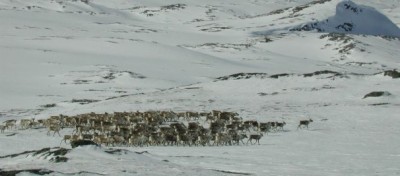Wildlife authorities fear that two large herds of wild reindeer that roam Norway’s central mountain plateau called Hardangervidda have been infected with Chronic Wasting Disease (CWD). They also fear that the only way to halt the spread of the disease is through a mass slaughter of as many as 13,000 of the majestic animals.

“This is terribly dramatic,” Olav Strand, a biologist for the Norwegian institute for nature research (NINA), told Norwegian Broadcasting (NRK) on Tuesday. “We’ve never done anything like this. There’s nothing about this in our texbooks, but with the knowledge we have today, destroying the animals is unfortunately the only way to get rid of CWD (also known as skrantesyke in Norwegian).”
Three sick reindeer have been found in a herd at Nordfjella, south of Hemsedalsfjellet. Experts believe there are more sick animals there, and fear the emaciating brain disease will spread to both tame reindeer and other wild deer. Some reindeer have been spotted with their heads hanging down, drool coming from their mouths and an unusual absence of being frightened by people.
‘Just so depressing’
Norway’s foremost experts on CWD were meeting in the mountain town of Geilo on Tuesday to deal with the looming tragedy. It’s the second to hit the wild reindeer herd since around 300 animals were found dead last August on Hardanger. They were believed to have been struck by lightning.
Norway has long been proud of Europe’s last remaining herds of wild reindeer, and is entrusted to making sure they survive for generations to come. “This is just so depressing,” NINA researcher Bjørnar Ytrehus said while warning against the dramatic consequences of not managing to stop the spread of the disease now threatening the herds.
“This is like a creeping crisis that can wipe out our entire deer population as well within 50 to 150 years,” Ytrehus said. Both deer and moose in the area are also vulnerable to becoming infected. There are no indications that CWD can infect humans, “but at the same time,” Ytrehus said, “we’re afraid that could happen, and that would have enormous consequences.”
Selective shooting option
One alternative to destroying the entire wild reindeer population of around 13,000 in the Hemsedal-Hardanger area would be to shoot just a portion of the herds, to reduce the population and keep it small over time.
“But then we have to ask ourselves what kind of wild reindeer population shall we have,” mused Strand, the NINA biologist. “Would we still have some that are sick, or shall we take on the demanding job of trying to maintain a herd that’s healthy? I think everyone would agree that it’s not acceptable to have wild reindeer that are not healthy.”
CWD was first detected near Hemsedal last fall, and the state provided around NOK 7 million in extra funding to try to fight it. State officials have significantly increased their monitoring of animals at Nordfjella, and they’re instructed to shoot animals showing symptoms of the disease. There also have been attempts to erect fences to try to separate herds.
No one has been able to determine how or why the animals started falling ill. “We’re all wondering about that, and we may never get an answer,” veterinarian Julie Grimstad of the state food safety agency Mattilsynet told NRK. “We don’t know how long the disease has been around on Nordfjella, so there’s a lot of uncertainty.”
newsinenglish.no/Nina Berglund

